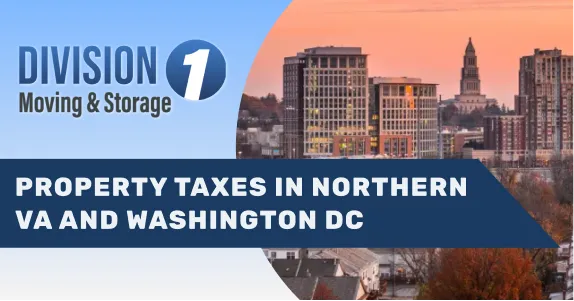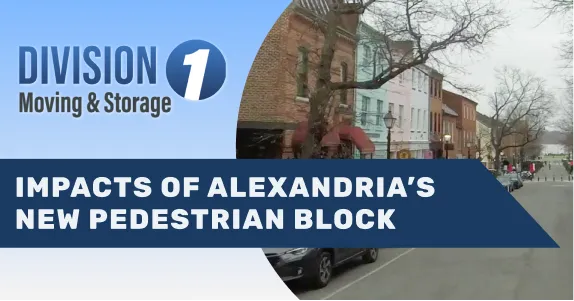Moving to Washington D.C. is exciting, but navigating the Washington DC neighborhood map can be challenging. It's a big step, not just moving your belongings but also adjusting to a new environment and lifestyle.
Division 1 Moving & Storage knows every part of the Washington DC neighborhood map. Our expertise ensures your move is smooth and well-coordinated. We're more than movers; we're your partners in this new chapter, customizing our services for anywhere from Georgetown's historic lanes to Adams Morgan's lively streets.
In this guide, you'll find essential tips and insights for moving to D.C. We use our deep knowledge of the Washington DC neighborhood map to ease your worries. Read on for a comprehensive look at D.C.’s neighborhoods and learn how we make your move to the city seamless and exciting.
Understanding Washington D.C.'s Layout
Understanding the map of Washington DC neighborhoods is crucial for anyone looking to move to or within the capital. The city's unique quadrant system, centered around the Capitol Building, offers a diverse array of lifestyles and communities. Each quadrant has its distinct personality and offerings, catering to various preferences and needs.

Northwest (NW)
- Cultural Hub: NW is home to numerous cultural institutions, including the Smithsonian Zoos and art museums. It's a blend of entertainment, history, and education.
- Affluent Communities: This quadrant boasts some of the most affluent neighborhoods, like Georgetown and Kalorama, offering upscale living and high-end amenities.
Northeast (NE)
- Diverse and Dynamic: NE is characterized by its diversity, with neighborhoods like Brookland showcasing a mix of students, artists, and families.
- Historical Charm: It is known for historic districts such as Capitol Hill, combining rich history with a lively, community-centric atmosphere.
Southeast (SE)
- Rapid Development: SE has seen significant development recently, especially around the Navy Yard and Capitol Riverfront, offering modern living and waterfront activities.
- Cultural Diversity: Areas like Anacostia are rich in African American culture and history, providing a unique and enriching community experience.
Southwest (SW)
- Waterfront Living: SW is known for its waterfront district, offering leisure and recreational activities along the Potomac River.
- Urban Renewal: This quadrant has undergone urban renewal, with new developments in areas like the Wharf, blending modern living with vibrant nightlife and dining options.
The street grid in D.C. is straightforward once understood. Numbered streets run north and south, lettered streets run east and west, and state-named avenues run diagonally. It's important to note the quadrant in addresses, as many streets and addresses exist in more than one quadrant.
The history of D.C.'s street naming system reflects its expansion and development. Initially, streets were named alphabetically with one-syllable names. As the city grew, the system included two-syllable names, then three-syllable names, and in the Northwest quadrant, the fourth alphabet uses plant names.
Detailed Look at Key Neighborhoods
When examining the Washington D.C. neighborhood map, it is clear each has its distinct character, and caters to a variety of preferences and lifestyles. Whether it's the historic ambiance, political significance, or cultural vibrancy, each area offers its unique charm.

Georgetown
- Historic Georgetown: Known for its well-preserved architecture and cobblestone streets, Georgetown reflects a rich historical heritage.
- Upscale Lifestyle: The area boasts luxury shopping, fine dining, and exclusive residential options.
- Waterfront Elegance: Alongside the scenic Potomac River, Georgetown's waterfront is a hub of activity and beauty.
- Educational Prestige: Home to the esteemed Georgetown University, the neighborhood is a blend of academic and cultural sophistication.
Capitol Hill
- Heart of Politics: Living in Capitol Hill means residing near significant political landmarks, including the U.S. Capitol and Supreme Court.
- Diverse Community: Capitol Hill is celebrated for its vibrant mix of residents - from young professionals to established families, enhancing its dynamic atmosphere.
- Historical Significance: The area's rich history is evident in its architecture and community traditions.
- Active Local Scene: Capitol Hill is known for its active local markets, community events, and political gatherings, making it a lively place to live.
Adams Morgan
- Cultural Melting Pot: Known for its rich diversity, Adams Morgan is a vibrant neighborhood that has long been a welcoming hub for immigrants, contributing to its multicultural atmosphere.
- Historical Roots: The area's history is deeply embedded in its transformation from Lanier Heights to its current, unity-emphasizing name, Adams Morgan, derived from two local schools. This history is marked by its role in fostering diversity and community integration.
- Eclectic Dining Scene: Adams Morgan is a haven for food lovers, offering an array of global cuisines. From cozy coffee houses to 24/7 diners, the neighborhood caters to every palate, making it a foodie's paradise.
- Nightlife and Entertainment: The neighborhood is celebrated for its dynamic nightlife, with a range of bars, clubs, and live music venues that draw both locals and visitors for unforgettable evenings.
Financial Considerations for Living in D.C.
Financial considerations are a crucial aspect of moving to or living in Washington D.C. Understanding the cost of living and budgeting effectively is essential for a comfortable lifestyle.
- Cost of Living: D.C. is known for its relatively high cost of living, which includes expenses like utilities, groceries, and transportation, in addition to housing.
- Budgeting for Comfort: It's recommended that housing costs should not exceed 30% of one’s monthly income for financial comfort and stability.
- Housing Costs: The average rent for a two-bedroom apartment in D.C. is around $1,786, necessitating a substantial income.
- Income Requirements: To comfortably afford average housing in D.C., a minimum annual income of approximately $71,440 is advised.
- Planning for Expenses: Prospective residents should budget for additional living expenses beyond rent, including healthcare, entertainment, and savings.
- Financial Assistance and Programs: For those needing assistance, D.C. offers various programs and subsidies to help with housing affordability.
Understanding these financial aspects is key to ensuring a balanced and comfortable life in Washington D.C., allowing residents to enjoy what the city offers without overextending financially.
The Hipster Vibe: Logan Circle and Dupont Circle
Logan Circle and Dupont Circle stand as vibrant embodiments of Washington D.C.'s eclectic and modern spirit. These neighborhoods, each with their unique charm, offer a plethora of experiences for the urban dweller and visitor alike. Here’s a closer look at the distinct characteristics these neighborhoods have to offer:
Logan Circle's Trendy Appeal
- Historical Exploration: Engage in a historical journey with the Logan Circle Heritage Trail, a self-guided tour that unveils the neighborhood's rich past and architectural marvels.
- Guided Architectural Tours: Opt for an expert-led experience with Washington Walks, diving deep into the Victorian architecture that defines Logan Circle.
- Franklin Square Park: This serene park, a testament to the area's historical significance, offers a quiet retreat amidst the city hustle.
- Cultural Hotspots: From the iconic Black Cat music venue to the comedy excellence of Washington Improv at the Source Theatre, Logan Circle buzzes with a diverse cultural scene.
Dupont Circle's Cultural Heart
- Arts and Performances: Dupont Circle is a mecca for art enthusiasts, with the Studio Theatre presenting cutting-edge contemporary plays.
- Culinary Delights: The neighborhood boasts a vibrant dining scene, from the famous Cork Wine Bar and Market to the exquisite French cuisine at Le Diplomate.
- Breakfast and Brunch Spots: Ted’s Bulletin offers a classic American breakfast experience, while Commissary is a go-to for a casual, no-frills dining experience.
- Café Culture: Enjoy a relaxed atmosphere at Colada Shop, known for its café con leche and sunny patio, perfect for a leisurely afternoon.
Both Logan Circle and Dupont Circle represent the dynamic and diverse character of Washington D.C. Offering a mix of historical insights, architectural beauty, and a vibrant cultural and dining scene, these neighborhoods cater to those seeking a lively and enriching urban experience.
Safest Spots on The Washington D.C. Neighborhood Map
Washington D.C.'s diverse neighborhoods contribute to a broad spectrum of safety, which is crucial for making informed decisions about living or traveling in the area. The city overall has been rated with an A- safety grade, indicating a lower crime rate compared to the average U.S. city. This rating places Washington D.C. in the 80th percentile for safety, meaning it is safer than 80% of U.S. cities.

The overall crime rate in Washington D.C. is 33.30 per 1,000 residents, but this figure varies across different parts of the city. The northwest part of the city, for example, is generally perceived as the safest area. This is reflected in the lower probability of becoming a victim of crime in these neighborhoods.
In contrast, some eastern neighborhoods of Washington D.C. experience higher crime rates. In these areas, the likelihood of becoming a victim of crime can be as high as 1 in 16. On the other hand, in the northwest part of the city, this likelihood is significantly lower, at about 1 in 86.
Safety Overview in Washington D.C.
Navigating the safety landscape of Washington D.C. requires an understanding of how it varies across the city’s diverse neighborhoods. From tranquil, low-crime areas to those actively working on improving safety, the city presents a wide spectrum of living environments.
- Diverse Safety Landscape: The level of safety in Washington D.C. differs markedly from one neighborhood to another. Some areas boast serene, low-crime environments, while others are still grappling with higher crime rates.
- Importance of Data-Driven Insights: For a realistic understanding of safety in different neighborhoods, turning to recent crime statistics and safety reports is essential. This data offers an objective lens through which to view the city’s safety landscape.
- Effectiveness of Community Policing: The introduction of community policing in many D.C. neighborhoods has been a key factor in reducing crime and fostering a safer community environment.
- Influence of Public Perception: The feeling of safety in a neighborhood often hinges on personal experiences and the degree of community interaction, emphasizing the importance of getting to know an area first-hand.
Highlighting Safety Across D.C. Neighborhoods:
A closer look at the neighborhood map of Washington D.C. reveals a varied safety map, with some areas known for their tranquility and others in the midst of safety improvements.
- Notably Safe Areas: Georgetown, Woodley Park, and Cleveland Park stand out for their low crime rates, making them some of the safest neighborhoods in D.C.
- Areas with Higher Crime Rates: Certain neighborhoods, particularly in the Eastern and Southeastern sectors of the city, have historically faced higher crime rates, but are seeing continuous efforts to improve safety.
- Neighborhoods on the Rise: Neighborhoods like the U-Street Corridor and Columbia Heights are experiencing positive changes in safety, thanks to concerted community and development efforts.
- Staying Informed and Involved: Active participation in local safety initiatives and community meetings is crucial for residents and visitors to contribute to the ongoing improvement of neighborhood safety.
Making Your Washington D.C. Neighborhood Choice
Making the right neighborhood choice in Washington D.C. involves carefully considering various factors that affect your daily life and well-being. It’s about finding a balance between your lifestyle preferences, financial capabilities, and personal or family needs. Here’s an expanded view of what to keep in mind when selecting a neighborhood in D.C.:

- Lifestyle Preferences: Your lifestyle plays a pivotal role in choosing a neighborhood. If you prefer a vibrant nightlife and cultural activities, areas like Dupont Circle or the U-Street Corridor might appeal to you. For a quieter, more family-oriented environment, neighborhoods like Woodley Park or Cleveland Park could be more suitable.
- Budget Considerations: Financial constraints are a significant factor. Upscale neighborhoods like Georgetown and Kalorama offer luxury living but at a higher cost. More affordable options might be found in up-and-coming areas like Columbia Heights or Petworth.
- Proximity to Work and Education: Consider the commute to your workplace or educational institutions. Living in a neighborhood like Capitol Hill could be advantageous for those working in government or politics, while Foggy Bottom is ideal for those affiliated with George Washington University.
- Community and Social Environment: The community vibe can greatly influence your experience. Areas like Adams Morgan are known for their diverse and inclusive community, while areas like Georgetown have a more established, upscale social environment.
- Access to Amenities: Easy access to amenities such as parks, grocery stores, restaurants, and public transportation is crucial. Neighborhoods like Dupont Circle and NoMa offer numerous amenities within walking distance.
Choosing Division 1 Moving & Storage for Your Move to a Washington D.C. Neighborhood
Embarking on a journey to a new home in Washington D.C. can be both thrilling and overwhelming. At Division 1 Moving & Storage, we understand the complexities and nuances of city moving. Our team is committed to ensuring your transition to any D.C. neighborhood is as smooth and stress-free as possible.
.webp)
- Local Expertise: We pride ourselves on our intimate knowledge of Washington D.C.’s unique layout and character. Our experienced team effortlessly navigates through the city’s streets, making us experts in handling the specific challenges of each D.C. neighborhood.
- Personalized Moving Solutions: Understanding that every move is unique, we offer customized moving solutions tailored to your specific needs. Whether you’re settling into a cozy apartment in Capitol Hill or a spacious home in Georgetown, our services are designed to fit your individual situation perfectly.
- Comprehensive Services: Our comprehensive range of services covers every aspect of moving, from packing to storage. We handle all the details, ensuring a seamless transition so you can focus on enjoying your new home in Washington D.C.
- Quality and Care: At Division 1 Moving & Storage, we treat your belongings with the utmost care and respect. We recognize the importance of your possessions and handle them as if they were our own, ensuring they arrive safely and securely at your new D.C. home.
- Stress-Free Experience: Our goal is to make your moving experience as stress-free as possible. From the initial planning stages to the final unpacking, we are with you every step of the way, providing support and guidance to make your move to Washington D.C. a pleasant and memorable journey.
%201.webp)








.webp)


























.webp)



